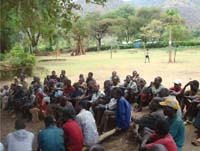11.3.1 Group dynamics
Observing group dynamics tells us what is happening among the group members and in the group itself. The effectiveness of group functioning depends on several different factors including the following.
Size of a group
Many people feel that 8–12 is the ideal size for a group, but really it depends on the aims and purpose of the group. The larger the group, the less contribution individual members are able to make — and poor decisions may be the result.
The background of group members
Who the group members are and their reason for attending will also determine the group dynamics (Figure 11.6). If the members are sent by their employers to attend they may not be interested and may consider that having to attend the group is a form of punishment.

The nature of the task
The extent to which the task is concerned with producing results, or alternatively, with promoting the wellbeing of the members of the group, will change the nature of each group.
Group decision-making
Decision-making depends on the complexity of the decisions taken and the range of skills and expertise in the group. The ways of reaching decisions in the group will also affect the group dynamics. Decision-making can be through consensus, which involves everyone’s agreement, or through voting, in which case decisions will be decided on a majority vote.
Think of a group in which you have recently been involved (it doesn’t need to be a health education group). Look again at the three factors affecting group dynamics above and write down how each item affected the group that you were involved in.
We cannot know what your answer is to this question, but we hope that it has helped you use your own experience to begin to think about how groups work. You may have noted that a large group tends to ‘lose’ the contributions of individual members, and perhaps gives a chance for one unhelpful person to dominate proceedings. Were you able to identify the task clearly? Perhaps you noted how decisions were reached — again there are differences between small and large groups. Better decisions are often reached in smaller groups.
Individual roles of members
Within each group there will be a range of individual personalities. Some people will be helpful, while others are disruptive or shy. After a short time of working with the group you will begin to recognise the patterns of each person’s individual behaviour and how they all function together as a group.
Pattern of leadership
How well a group performs often depends a great deal on the quality of the leadership and the leadership style used by the leader.
There are three main styles of leadership that you might recognise:
- In the authoritarian approach the leader is the only person to decide about issues for the group. He or she might say something like, ‘I am in charge’. This style will often reduce creativity of the other group members and limit the output of the group.
- A leader using the democratic approach consults the group to make decisions. He or she might say something like, ‘Let’s all try to work out what will be the best approach’. This style is where the leader acts as a facilitator and helps everyone to work together. But when it becomes necessary they can provide a stimulus to action if the meeting is stuck and failing to reach a decision.
- ‘Laissez-faire’ literally means ‘to leave to do’, or to do nothing. This style of leader may say something like, ‘Do whatever you want’. If a group leader does not use their role effectively as leader the entire group may become very disorganised and inefficient.
On the whole, if you were to be a group leader, which style of leadership do you think might work best in the field of health education?
Health education with groups seems to work well with participation so the democratic approach — where things are worked out together with the leader acting as facilitator — may well be the most effective approach.
So, it is important to think about your own role as a group leader in the future and how you might best lead health education groups.
11.3 Health education with groups
